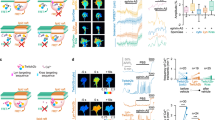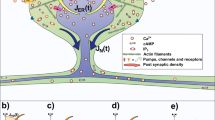Abstract
Growth cones at the tips of extending neurites migrate through complex environments in the developing nervous system and guide axons to appropriate target regions using local cues1,2. The intracellular calcium concentration ([Ca2+]i) of growth cones correlates with motility in vitro3,4,5,6,7, but the physiological links between environmental cues and axon growth in vivo are unknown. Here we report that growth cones generate transient elevations of [Ca2+]i as they migrate within the embryonic spinal cord and that the rate of axon outgrowth is inversely proportional to the frequency of transients. Suppressing Ca2+ transients by photorelease of a Ca2+ chelator accelerates axon extension, whereas mimicking transients with photorelease of Ca2+ slows otherwise rapid axonal growth. The frequency of Ca2+ transients is cell-type specific and depends on the position of growth cones along their pathway. Furthermore, growth-cone stalling and axon retraction, which are two important aspects of pathfinding8,9,10, are associated with high frequencies of Ca2+ transients. Our results indicate that environmentally regulated growth-cone Ca2+ transients control axon growth in the developing spinal cord.
This is a preview of subscription content, access via your institution
Access options
Subscribe to this journal
Receive 51 print issues and online access
$199.00 per year
only $3.90 per issue
Buy this article
- Purchase on Springer Link
- Instant access to full article PDF
Prices may be subject to local taxes which are calculated during checkout




Similar content being viewed by others
References
Goodman, C. S. & Shatz, C. Developmental mechanisms that generate precise patterns of neuronal connectivity. Cell/Neuron 72/10, 77–98 (1993).
Tessier-Lavigne, M. & Goodman, C. S. The molecular biology of axon guidance. Science 274, 1123 –1133 (1996).
Gomez, T. M., Snow, D. M. & Letourneau, P. C. Characterization of spontaneous calcium transients in nerve growth cones and their effect on growth cone migration. Neuron 14, 1233–1246 ( 1995).
Kater, S. B. & Mills, L. R. Regulation of growth cone behavior by calcium. J. Neurosci. 11, 891– 899 (1991).
Kater, S. B., Mattson, M. P., Cohan, C. & Connor, J. Calcium regulation of the neuronal growth cone. Trends Neurosci. 11, 315–321 ( 1988).
Gu, X., Olson, E. C. & Spitzer, N. C. Spontaneous neuronal calcium spikes and waves during early differentiation. J. Neurosci. 14, 6325–6335 (1994).
Gu, X. & Spitzer, N. C. Distinct aspects of neuronal differentiation encoded by frequency of spontaneous Ca2+ transients. Nature 375, 784–787 (1995).
Godement, P., Wang, L. C. & Mason, C. A. Retinal axon divergence in the optic chiasm: dynamics of growth cone behavior at the midline. J. Neurosci. 14, 7024–7039 (1994).
Ghosh, A. & Shatz, C. J. Pathfinding and target selection by developing geniculocortical axons. J.Neurosci. 12 , 39–55 (1992).
Myers, P. Z. & Bastiani, M. J. Growth cone dynamics during the migration of an identified commissural growth cone. J. Neurosci. 13, 127–143 ( 1993).
Roberts, A. & Clarke, J. D. W. The neuroanatomy of an amphibian embryo spinal cord. Phil. Trans. R. Soc. Lond. B 296 , 195–212 (1982).
Tymianski, M., Sattler, R., Bernstein, G. & Jones, O. T. Preparation, characterization and utility of a novel antibody for resolving the spatial and temporal dynamics of the calcium chelator BAPTA. Cell Calcium 22, 111–120 (1997).
Bovolenta, P. & Mason, C. A. Growth cone morphology varies with position in the developing mouse visual pathway from retina to first targets. J. Neurosci. 7, 1447–1460 (1987).
Tosney, K. W. & Landmesser, L. T. Development of the major pathways for neurite outgrowth in the chick hindlimb. Dev. Biol. 109, 193–214 (1985).
Zheng, J. Q., Felder, M., Connor, J. A. & Poo, M. Turning of nerve growth cones induced by neurotransmitters. Nature 368, 140–144 (1994).
Lagenaur, C. & Lemmon, V. An L1-like molecule, the 8D9 antigen, is a potent substrate for neurite extension. Proc. Natl Acad. Sci. USA 84, 7753–7757 ( 1987).
Hagg, T., Portera-Cailliau, C., Jucker, M. & Engvall, E. Laminins of the adult mammalian CNS; laminin-alpha2 (merosin M-) chain immunoreactivity is associated with neuronal processes. Brain Res. 764 , 17–27 (1997).
Varela-Echavarria, A., Tucker, A., Puschel, A. W. & Guthrie, S. Motor axon subpopulations respond differentially to the chemorepellents netrin-1 and semaphorin D. Neuron 18, 193– 207 (1997).
Colamarino, S. A. & Tessier-Lavigne, M. The axonal chemoattractant netrin-1 is also a chemorepellent for trochlear motor axons. Cell 81, 621–629 (1995).
Snow, D. M., Atkinson, P., Hassinger, T., Kater, S. B. & Letourneau, P. C. Growth cone intracellular calcium levels are elevated upon contact with sulfated proteolgycans. Dev. Biol. 166, 87–100 ( 1994).
Komuro, H. & Rakic, P. Intracellular Ca2+ fluctuations modulate the rate of neuronal migration. Neuron 17, 275–285 (1996).
Nieuwkoop, J. M. & Faber, J. Normal Table of Xenopus Laevis (Daudin): A Systematic and Chronological Survey of the Development of the Fertilized Egg Till the End of Metamorphosis 2nd edn (North-Holland, Amsterdam, (1967)).
Chien, C. B., Rosenthal, D. E., Harris, W. A. & Holt, C. E. Navigational errors made by growth cones without filopodia in the embryonic Xenopus brain. Neuron 11, 237– 251 (1993).
McFarlane, S., McNeill, L. & Holt, C. E. FGF signaling and target recognition in the developing Xenopus visual system. Neuron 15, 1017 –1028 (1995).
Tymianski, M. et al. Anovel use for a carbodiimide compound for the fixation of fluorescent and non-fluorescent calcium indicators in situ physiological experiments. Cell Calcium 21, 175– 183 (1997).
Acknowledgements
We thank S. Watt and I. Hsieh for technical assistance, and M. Ferrari and M.-M. Poo for comments on the manuscript. Research supported by a NIH NINDS fellowship to T.M.G. and grant to N.C.S.
Author information
Authors and Affiliations
Rights and permissions
About this article
Cite this article
Gomez, T., Spitzer, N. In vivo regulation of axon extension and pathfinding by growth-cone calcium transients. Nature 397, 350–355 (1999). https://doi.org/10.1038/16927
Received:
Accepted:
Issue Date:
DOI: https://doi.org/10.1038/16927
This article is cited by
-
Subcellular second messenger networks drive distinct repellent-induced axon behaviors
Nature Communications (2023)
-
Calcium signaling in neurodevelopment and pathophysiology of autism spectrum disorders
Molecular Biology Reports (2022)
-
Endoplasmic Reticulum in Metaplasticity: From Information Processing to Synaptic Proteostasis
Molecular Neurobiology (2022)
-
Caveolin 1 is required for axonal outgrowth of motor neurons and affects Xenopus neuromuscular development
Scientific Reports (2020)
-
Pioneer axons employ Cajal’s battering ram to enter the spinal cord
Nature Communications (2019)
Comments
By submitting a comment you agree to abide by our Terms and Community Guidelines. If you find something abusive or that does not comply with our terms or guidelines please flag it as inappropriate.



